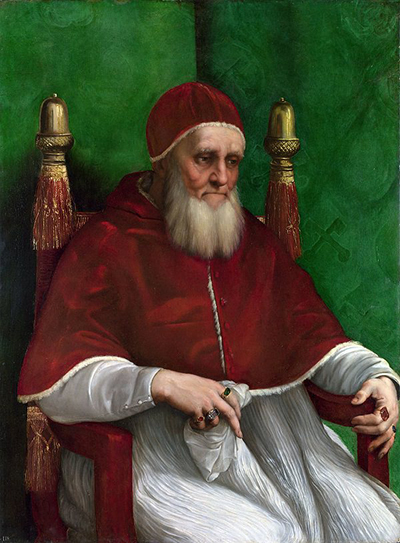The portrait of Pope Julius II by Raffaello Sanzio da Urbino, better known as Raphael, dates between June 1511 and March 1512. Commissioned by Julius II, Raphael's oil painting would become one of inspiration and admiration - influencing the future of papal portraiture.
Prior to Raphael's portrait of Pope Julius II, the sitter would normally be portraited in the kneeling position or frontal profile. Raphael's version was very unusual for this particular era. The artist's portrayal was astonishingly realistic, showing an incredibly lifelike representation and encouraging debate as to what Julius II was going through at the time. His face shows one of sorrow and gloom. He appears to be inattentive and withdrawn. The painting was expected to depict a powerful person, yet displays him with vulnerability.
Raphael's unprecedented formula of papal portraiture would go on to influence most future painters. Artists including Sebastino del Piombo and Diego Velazquez were two of many famous artists that would follow this method. The striking chair finials are golden acorns and represent the Della Rovere family. Della Rovere (literally translates to 'of the oak tree'), were believed to have their heraldic oak tree painted in the original portrait of Pope Julius II which was since overpainted several times.
There are many versions and copies of this particular portrait but it was generally believed that the original painting was kept at the Uffizi Gallery in Florence and that the National Gallery in London owned another version. However, in 1969 it was requested that the National Gallery were to take x-ray photographs of the painting which would spark a controversial debate as to the location of the original.
The x-rays revealed that behind the chair, the background had been repainted in its entirety. It was already known that Raphael overpainted the background himself. The first painting showed a dark blue background featuring a blue and gold textile with gold emblems. Raphael overpainted this with the green cloth. The background was then repainted with a plain dark background before 1824. The results of this research was published by Cecil Gould of the National Gallery in 1970. This proof was overall generally accepted. A cleaning process and restoration of the original painting would now take place. During the cleaning process, the plain dark background was removed leaving the green textile and this is what can now be seen. The green background however was said to be over cleaned, revealing a much brighter green than intended.
Despite the portrait being classed as in excellent condition by the National Gallery, the harsh and excessive cleaning was also blamed for other areas of damage. The pope's hands, exhibiting his love of large jewelled rings, have been slightly compromised at the ends. Whiskers from the pope's beard that were apparent before the cleaning process have now disappeared. There is a small scratch that has appeared on his forehead and the arms of the chair lack certain definition following the cleaning.




